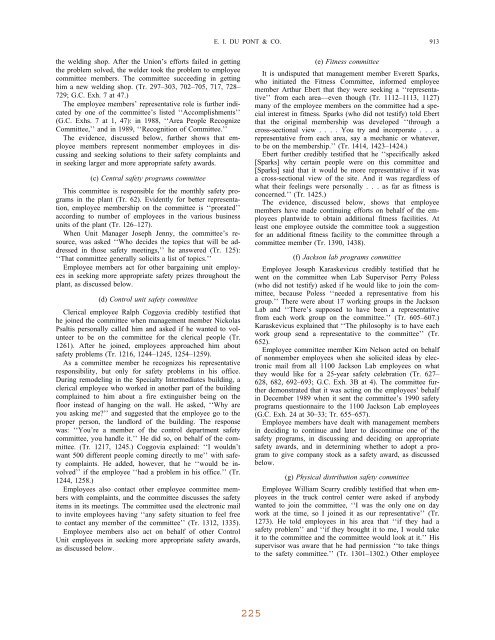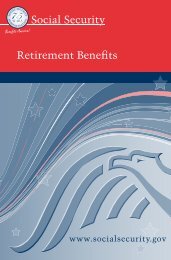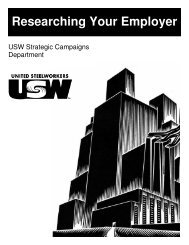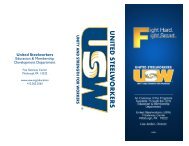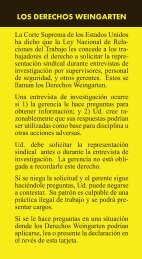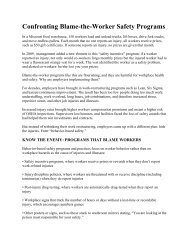Union Approach to Health and Safety: - United Steelworkers
Union Approach to Health and Safety: - United Steelworkers
Union Approach to Health and Safety: - United Steelworkers
You also want an ePaper? Increase the reach of your titles
YUMPU automatically turns print PDFs into web optimized ePapers that Google loves.
E. I. DU PONT & CO.<br />
913<br />
the welding shop. After the <strong>Union</strong>’s efforts failed in getting<br />
the problem solved, the welder <strong>to</strong>ok the problem <strong>to</strong> employee<br />
committee members. The committee succeeding in getting<br />
him a new welding shop. (Tr. 297–303, 702–705, 717, 728–<br />
729; G.C. Exh. 7 at 47.)<br />
The employee members’ representative role is further indicated<br />
by one of the committee’s listed ‘‘Accomplishments’’<br />
(G.C. Exhs. 7 at 1, 47): in 1988, ‘‘Area People Recognize<br />
Committee,’’ <strong>and</strong> in 1989, ‘‘Recognition of Committee.’’<br />
The evidence, discussed below, further shows that employee<br />
members represent nonmember employees in discussing<br />
<strong>and</strong> seeking solutions <strong>to</strong> their safety complaints <strong>and</strong><br />
in seeking larger <strong>and</strong> more appropriate safety awards.<br />
(c) Central safety programs committee<br />
This committee is responsible for the monthly safety programs<br />
in the plant (Tr. 62). Evidently for better representation,<br />
employee membership on the committee is ‘‘prorated’’<br />
according <strong>to</strong> number of employees in the various business<br />
units of the plant (Tr. 126–127).<br />
When Unit Manager Joseph Jenny, the committee’s resource,<br />
was asked ‘‘Who decides the <strong>to</strong>pics that will be addressed<br />
in those safety meetings,’’ he answered (Tr. 125):<br />
‘‘That committee generally solicits a list of <strong>to</strong>pics.’’<br />
Employee members act for other bargaining unit employees<br />
in seeking more appropriate safety prizes throughout the<br />
plant, as discussed below.<br />
(d) Control unit safety committee<br />
Clerical employee Ralph Coggovia credibly testified that<br />
he joined the committee when management member Nickolas<br />
Psaltis personally called him <strong>and</strong> asked if he wanted <strong>to</strong> volunteer<br />
<strong>to</strong> be on the committee for the clerical people (Tr.<br />
1261). After he joined, employees approached him about<br />
safety problems (Tr. 1216, 1244–1245, 1254–1259).<br />
As a committee member he recognizes his representative<br />
responsibility, but only for safety problems in his office.<br />
During remodeling in the Specialty Intermediates building, a<br />
clerical employee who worked in another part of the building<br />
complained <strong>to</strong> him about a fire extinguisher being on the<br />
floor instead of hanging on the wall. He asked, ‘‘Why are<br />
you asking me?’’ <strong>and</strong> suggested that the employee go <strong>to</strong> the<br />
proper person, the l<strong>and</strong>lord of the building. The response<br />
was: ‘‘You’re a member of the control department safety<br />
committee, you h<strong>and</strong>le it.’’ He did so, on behalf of the committee.<br />
(Tr. 1217, 1245.) Coggovia explained: ‘‘I wouldn’t<br />
want 500 different people coming directly <strong>to</strong> me’’ with safety<br />
complaints. He added, however, that he ‘‘would be involved’’<br />
if the employee ‘‘had a problem in his office.’’ (Tr.<br />
1244, 1258.)<br />
Employees also contact other employee committee members<br />
with complaints, <strong>and</strong> the committee discusses the safety<br />
items in its meetings. The committee used the electronic mail<br />
<strong>to</strong> invite employees having ‘‘any safety situation <strong>to</strong> feel free<br />
<strong>to</strong> contact any member of the committee’’ (Tr. 1312, 1335).<br />
Employee members also act on behalf of other Control<br />
Unit employees in seeking more appropriate safety awards,<br />
as discussed below.<br />
(e) Fitness committee<br />
It is undisputed that management member Everett Sparks,<br />
who initiated the Fitness Committee, informed employee<br />
member Arthur Ebert that they were seeking a ‘‘representative’’<br />
from each area—even though (Tr. 1112–1113, 1127)<br />
many of the employee members on the committee had a special<br />
interest in fitness. Sparks (who did not testify) <strong>to</strong>ld Ebert<br />
that the original membership was developed ‘‘through a<br />
cross-sectional view .... You try <strong>and</strong> incorporate . . . a<br />
representative from each area, say a mechanic or whatever,<br />
<strong>to</strong> be on the membership.’’ (Tr. 1414, 1423–1424.)<br />
Ebert further credibly testified that he ‘‘specifically asked<br />
[Sparks] why certain people were on this committee <strong>and</strong><br />
[Sparks] said that it would be more representative if it was<br />
a cross-sectional view of the site. And it was regardless of<br />
what their feelings were personally . . . as far as fitness is<br />
concerned.’’ (Tr. 1425.)<br />
The evidence, discussed below, shows that employee<br />
members have made continuing efforts on behalf of the employees<br />
plantwide <strong>to</strong> obtain additional fitness facilities. At<br />
least one employee outside the committee <strong>to</strong>ok a suggestion<br />
for an additional fitness facility <strong>to</strong> the committee through a<br />
committee member (Tr. 1390, 1438).<br />
(f) Jackson lab programs committee<br />
Employee Joseph Karaskevicus credibly testified that he<br />
went on the committee when Lab Supervisor Perry Poless<br />
(who did not testify) asked if he would like <strong>to</strong> join the committee,<br />
because Poless ‘‘needed a representative from his<br />
group.’’ There were about 17 working groups in the Jackson<br />
Lab <strong>and</strong> ‘‘There’s supposed <strong>to</strong> have been a representative<br />
from each work group on the committee.’’ (Tr. 605–607.)<br />
Karaskevicus explained that ‘‘The philosophy is <strong>to</strong> have each<br />
work group send a representative <strong>to</strong> the committee’’ (Tr.<br />
652).<br />
Employee committee member Kim Nelson acted on behalf<br />
of nonmember employees when she solicited ideas by electronic<br />
mail from all 1100 Jackson Lab employees on what<br />
they would like for a 25-year safety celebration (Tr. 627–<br />
628, 682, 692–693; G.C. Exh. 3B at 4). The committee further<br />
demonstrated that it was acting on the employees’ behalf<br />
in December 1989 when it sent the committee’s 1990 safety<br />
programs questionnaire <strong>to</strong> the 1100 Jackson Lab employees<br />
(G.C. Exh. 24 at 30–33; Tr. 655–657).<br />
Employee members have dealt with management members<br />
in deciding <strong>to</strong> continue <strong>and</strong> later <strong>to</strong> discontinue one of the<br />
safety programs, in discussing <strong>and</strong> deciding on appropriate<br />
safety awards, <strong>and</strong> in determining whether <strong>to</strong> adopt a program<br />
<strong>to</strong> give company s<strong>to</strong>ck as a safety award, as discussed<br />
below.<br />
(g) Physical distribution safety committee<br />
Employee William Scurry credibly testified that when employees<br />
in the truck control center were asked if anybody<br />
wanted <strong>to</strong> join the committee, ‘‘I was the only one on day<br />
work at the time, so I joined it as our representative’’ (Tr.<br />
1273). He <strong>to</strong>ld employees in his area that ‘‘if they had a<br />
safety problem’’ <strong>and</strong> ‘‘if they brought it <strong>to</strong> me, I would take<br />
it <strong>to</strong> the committee <strong>and</strong> the committee would look at it.’’ His<br />
supervisor was aware that he had permission ‘‘<strong>to</strong> take things<br />
<strong>to</strong> the safety committee.’’ (Tr. 1301–1302.) Other employee


